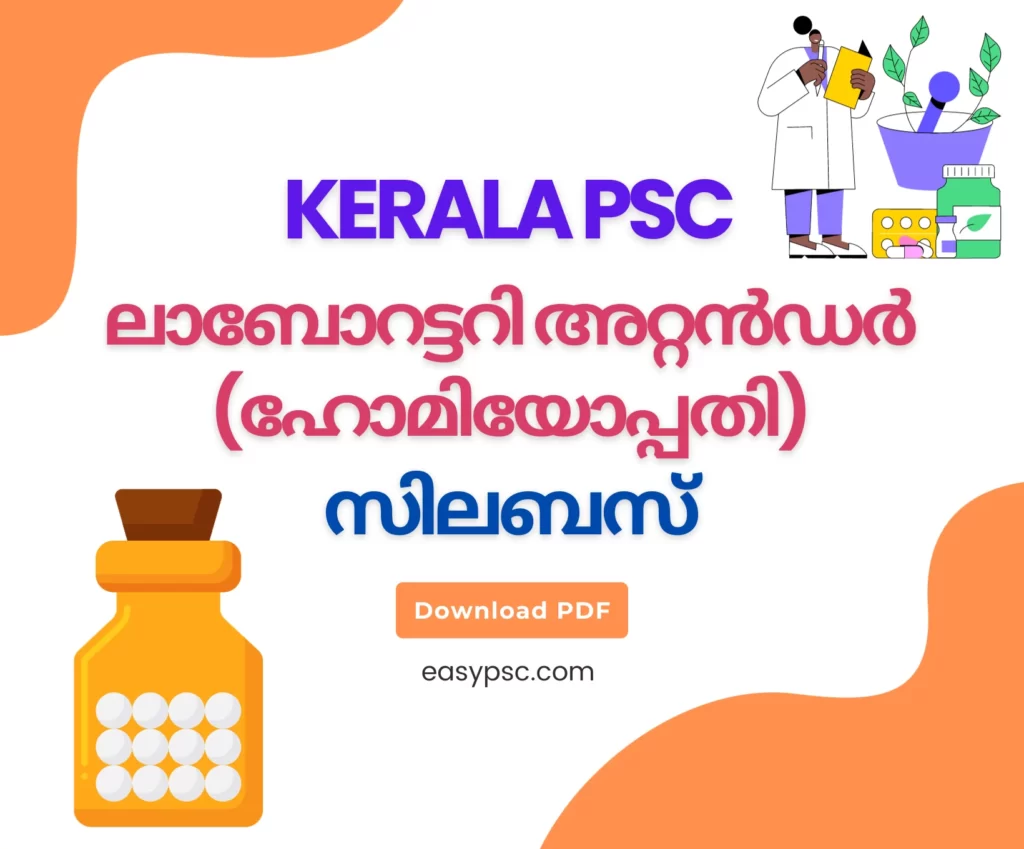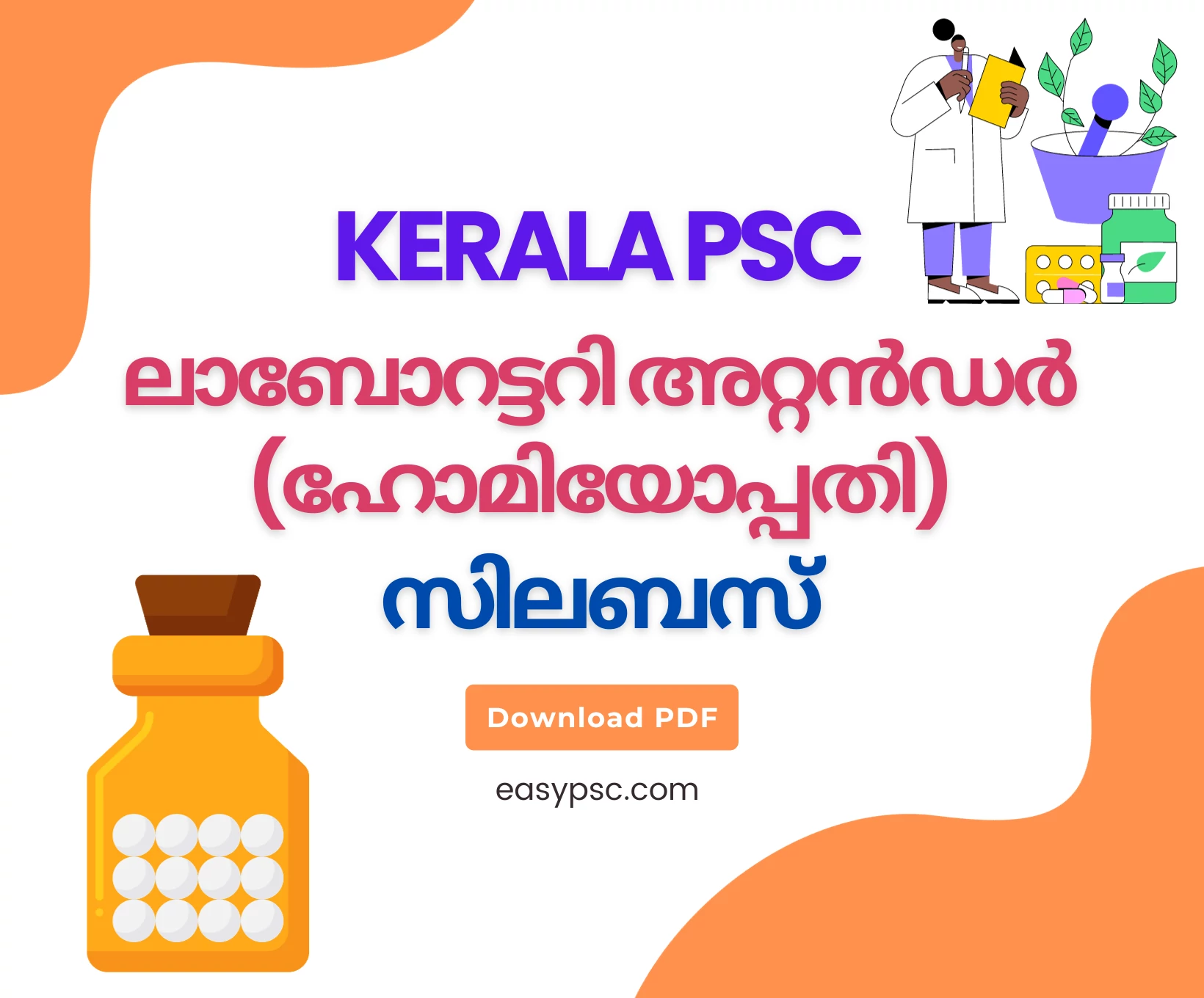
Kerala PSC Laboratory Attendant (Homeopathy) Syllabus – Download PDF: കേരള PSC 05 ജനുവരി 2024 ന് നടത്തുന്ന ഹോമിയോപ്പതി ഡിപ്പാർട്ട്മെന്റിലേക്കുള്ള ലാബോറട്ടറി അറ്റൻഡർ [Laboratory Attender (Homoeopathy)] പരീക്ഷയുടെ വിശദമായ സിലബസും പരീക്ഷാ പാറ്റേണും ഇവിടെ നിന്നും PDF രൂപത്തിൽ ഡൗൺലോഡ് ചെയ്യാം. 05-01-2024 വെള്ളിയാഴ്ച്ച രാവിലെ 07:15 മുതൽ 09:15 വരെയാണ് പരീക്ഷാ സമയം. 100 മാർക്കിന്റെ OMR പരീക്ഷയാണ് വരുന്നത്. കൺഫോർമേഷൻ നൽകിയ സമയത്ത് സെലക്ട് ചെയ്ത ഭാഷയിലായിരിക്കും ചോദ്യ പേപ്പർ ലഭിക്കുക. ഇംഗ്ലീഷ് ഭാഷയിരിക്കും ചോദ്യ പേപ്പർ ഉണ്ടാക്കുക. 22-12-2023 മുതൽ അഡ്മിഷൻ ടിക്കറ്റ് കേരള PSC യുടെ വൺ ടൈം പ്രൊഫൈൽ വഴി ഡൗൺലോഡ് ചെയ്യുവാൻ സാധിക്കും. സ്റ്റേറ്റ് വൈഡ് ആയി ആകെ 2379 പേരാണ് ഈ പരീക്ഷ എഴുതുവാൻ വേണ്ടി കൺഫോർമേഷൻ ചെയ്തിരിക്കുന്നത്.
Kerala PSC Laboratory Attendant (Homeopathy) Syllabus – Important Information
താഴെ കൊടുത്തിരിക്കുന്ന പട്ടികയിൽ നിന്നും കേരള PSC യുടെ ലാബോറട്ടറി അറ്റൻഡർ (ഹോമിയോപ്പതി) സിലബസിനെ പറ്റിയുള്ള എല്ലാ പ്രധാനപ്പെട്ട വിവരങ്ങളും ലഭിക്കുന്നതാണ്. kera
| പരീക്ഷ നടത്തുന്ന ഓർഗനൈസേഷൻ | കേരള പബ്ലിക് സർവീസ് കമ്മീഷൻ (KPSC) |
| കാറ്റഗറി | സിലബസ് |
| പരീക്ഷയുടെ പേര് | ലാബോറട്ടറി അറ്റൻഡർ (ഹോമിയോപ്പതി) |
| വകുപ്പ് | ഹോമിയോപ്പതി |
| കാറ്റഗറി നംബർ | 102/2023 |
| വിഷയം | ലാബോറട്ടറി അറ്റൻഡർ (ഹോമിയോപ്പതി) സിലബസ് |
| പരീക്ഷ തിയ്യതിയും സമയവും | 05/01/2024 വെള്ളിയാഴ്ച്ച 07:15 AM to 09:15 AM |
| അഡ്മിഷൻ ടിക്കറ്റ് ലഭ്യമാകുന്ന തിയ്യതി | 22/12/2023 |
| ആകെ പരീക്ഷ എഴുതുന്നവർ | 2379 |
| ഒഫീഷ്യൽ വെബ്സൈറ്റ് | www.keralapsc.gov.in |
Kerala PSC Laboratory Attendant (Homeopathy) Syllabus – Marks Distribution
കേരള PSC ലാബോറട്ടറി അറ്റൻഡർ (ഹോമിയോപ്പതി) പരീക്ഷയുടെ മാർക്ക് ഡിസ്ട്രിബ്യൂഷൻ ഒന്ന് നോക്കാം. അതായത് ഓരോ ഭാഗത്ത് നിന്നും ലഭിക്കുന്ന മാർക്കിന്റെ വിവരങ്ങൾ. ഇത് മനസിലാക്കിയാൽ ഏത് ഭാഗത്തിന് കൂടുതൽ പ്രാധാന്യം കൊടുക്കണം, ഏത് ഭാഗം കൂടുതൽ ആഴത്തിൽ പഠിക്കണം എന്നൊക്കെ മനസിലാക്കാൻ സാധിക്കും.
| Topics | Marks |
|---|---|
| Lab safety | 2 |
| Laboratory Management | 1 |
| Urine Analysis | 8 |
| Sputum Examination | 1 |
| Stool Analysis | 2 |
| Semen Analysis | 2 |
| CSF and other body fluids | 1 |
| Introduction to Biochemistry | 1 |
| Instruments used in Biochemistry | 2 |
| Blood Glucose Estimation | 2 |
| Renal Function Tests | 2 |
| Liver Function Tests | 4 |
| Lipid Profile | 1 |
| Other parameters of Diagnostic importance | 4 |
| Quality control in Biochemistry | 1 |
| Automation and Recent advances | 1 |
| Introduction to Microbiology | 1 |
| Structure and classification of bacteria | 2 |
| Sterilization and disinfection | 3 |
| Growth &Cultivation of Bacteria | 3 |
| Basic identification Techniques | 2 |
| Immunology and its diagnostic applications | 3 |
| Laboratory Diagnosis of Common Bacterial diseases | 4 |
| Laboratory Diagnosis of Common Bacterial Diseases | 1 |
| Laboratory Diagnosis of Common Viral Diseases | 2 |
| Lab Diagnosis of Malaria | 2 |
| Lab Diagnosis of Filariasis | 1 |
| Laboratory Diagnosis of Common Parasitic Diseases | 1 |
| Histotechnology | 1 |
| Tissue Processing | 2 |
| Diagnostic cytology | 2 |
| Basic Anatomy and Physiology | 5 |
| Diagnostic Laboratory | 3 |
| Blood and Phlebotomy | 5 |
| Lab Diagnosis of Intestinal Parasites | 15 |
| Blood Banking and Immunohaematology | 7 |
| Total | 100 |
Kerala PSC Laboratory Attendant (Homeopathy) Syllabus – Detailed Syllabus
കേരള PSC ലാബോറട്ടറി അറ്റൻഡർ (ഹോമിയോപ്പതി) പരീക്ഷയുടെ വിശദമായ സിലബസ് താഴെ നിങ്ങൾക്ക് കാണാവുന്നതാണ്. ഓരോ വിഷയങ്ങളും ഏത് ഭാഗത്ത് നിന്നും വരുന്നു എന്ന് കണ്ടെത്തി ചിട്ടയായ ഒരു പഠന രീതി ഉണ്ടാക്കിയെടുക്കുക. സിലബസും എക്സാമിന് ബാക്കിയുള്ള സമയവും വെച്ച് കൃത്യമായ ഒരു സ്റ്റഡി പ്ലാനും ടൈം ടേബിളും ഉണ്ടാക്കിയെടുക്കുക. കൃത്യമായി പഠിക്കുക. റാങ്ക് ലിസ്റ്റിൽ ഉയർന്ന ഒരു റാങ്ക് തന്നെ കരസ്ഥമാക്കുക. ഉടനെ ഒരു സർക്കാർ ജോലി എന്ന നിങ്ങളുടെ സ്വപ്നം നിറവേറ്റുക.
01. Lab safety (2 Mark)
Introduction – Signs and symbols used in a laboratory – Handling and storing chemicals in a laboratory. Laboratory Hazards-Physical, Chemical, Biological, Electrical, Fire, Radiation – Laboratory Safety Precautions-Personal – Hygiene Fire Extinguishers – Biomedical Waste Management First Aid – Practice in Laboratory
02. Laboratory Management (1 Mark)
- Introduction
- Code of Ethics of a Laboratory Professional
- Role of communication in laboratory
- Organization of a Laboratory
- Components of a Laboratory
- Lay out plan of a multi-room laboratory
- Organizational Pattern of a Laboratory
- Familiarization of Request forms and report forms. Ordering and Utilization of supplies
- Maintenance of Stock Registers- Consumables,
- Non-consumables
- Accreditation and Certification of Laboratories.
- Accrediting Agencies- NABL, ISO, CAP,
- CRISIL Barcoding and Total Laboratory Automation (TLA)
- Familiarization with Common Laboratory Software
- Clinical Pathology
- Introduction
- Importance, Common specimens, General guidelines for sample collection
03. Urine Analysis (8 Mark)
- Importance, Types of urine samples Methods of collection, preservatives Physical Examination
- Chemical Examination-Sugar, Protein, Blood, Ketone bodies, Bile pigments, Bile salts, Urobilinogen
- Microscopic Examination hCG test in Urine
04. Sputum Examination (1 Mark)
- Importance, Specimen collection
- Physical examination
- Microscopic examination
05. Stool Analysis (2 Mark)
- Importance, Specimen collection
- Physical examination
- Chemical examination- Occult blood, Reducing substances
- Microscopic examination- Saline and iodine mount
06. Semen Analysis (2 Mark)
- Importance, Specimen Collection
- Physical Examination, Liquefaction Time,
- Microscopy- Total Sperm Count, Motility, Morphology
- Chemical Examination-Fructose, Acid phosphatase
07. CSF and other body fluids (1 Mark)
- CSF- Introduction
- Specimen collection
- Physical & Microscopic Examination
- Chemical Examination- protein, glucose, chloride (Name of method of estimation & clinical significance only)
- Other body fluids
- Recent advances in Clinical pathology
08. Introduction to Biochemistry (1 Mark)
- Types of chemicals and preparation of solutions.
- Types of specimens in clinical Biochemistry
- Collection and processing of specimens for biochemical analysis
- Types of assays- Endpoint and Kinetic (definition and example only)
- Cleaning of glass wares for biochemical analysis
09. Instruments used in Biochemistry (2 Mark)
- Familiarise with Colorimeter, Spectrophotometer, Flame photometer, Centrifuge, Electronic balance, Distillation apparatus, Deionizer
10. Blood Glucose Estimation (2 Mark)
- Introduction to Diabetes – features, types, complications
- Types of samples- FBS, PPBS, RBS, Anticoagulant used
- Methods of estimation- GOD-POD in detail
- Normal Value and Clinical Significance
- Hyper and hypoglycemia
- Mention Glucometer Technique
- GTT and GCT procedures
- Mention relevance HbA1C
11. Renal Function Tests (2 Mark)
- Introduction, Common tests included
- Estimation of Blood Urea Mention common methods
- Urea-Berthelot method in detail, Normal value, and Clinical Significance
- Renal, Pre-renal, Post renal conditions of Uraemia
- Estimation of S. Creatinine. Mention common methods.
- Jaffe’s method in detail, Normal value, and Clinical Significance
- Estimation of Uric Acid. Mention common methods. Uricase method in detail.
- Normal Value and Clinical Significance.
- Mention Clearance tests- Urea and Creatinine
- Mention the Importance of Micro-albumin and Cystatin-C
12. Liver Function Tests (4 Mark)
- Introduction, Common tests included Bilirubin-Formation of Bilirubin
- Types of Bilirubin- conjugated and unconjugated Estimation of Bilirubin.
- Malloy- Evelyn method in detail. Normal Value and Clinical Significance
- Estimation of Total protein- Biuret method in details
- Estimation of Albumin- BCG method in details
- Normal value and clinical significance of total protein and
- Albumin, A-G Ratio.
- Other LFT Parameters- ALP, ALT, AST in brief
13. Lipid Profile (1 Mark)
- Introduction – Relevance, tests included in the Profile
- Estimation of S. Cholesterol. Mention common methods, CHOD-PAP method in detail,
- Normal Value and Clinical Significance
- Mention Triglycerides, HDL, LDL
14. Other parameters of Diagnostic importance (4 Mark)
- Serum Electrolytes- Serum Sodium and Potassium Normal Value and Clinical Significance
- Clinically important Minerals- Calcium and Phosphorus (normal value and significance only)
- Name Diagnostically important Hormones
- T3, T4, TSH, FSH, LH, Prolactin, progesterone
- Name Clinically important enzymes- Acid Phosphatase,
- S. Amylase, GGT,
- Name Cardiac markers- Troponin-I, Troponin-T CPK, CK-MB, LDH, SGOT
- Name Tumour Markers- CA-125, CEA, AFP,CA-19.9, PSA, Beta hCG
15. Quality control in Biochemistry (1 Mark)
- Introduction,
- Common terms used in Quality control,
- Errors – random and systemic, L.J. Chart,
- External QC and Internal QC
16. Automation and Recent advances (1 Mark)
- Need for Automation, Advantages of Automation
- Types of Auto Analysers-Semi and Fully automated Electrolyte Analyser (ISE) in brief
- Advanced Diagnostic Methods in Brief
- C.L.I.A., C.L.F.A, Turbidometry, Nephalometry, HPLC, Mention Point of care testing (POCT)
17. Introduction to Microbiology (1 Mark)
- Classification of Microbes, pathogens, commensals, types of Infections, infectious diseases, Carriers Historical
- aspects in Microbiology
18. Structure and classification of bacteria (2 Mark)
- Structure- Cell wall, flagella, fimbriae, capsule, spore, plasmid
- Classification of bacteria based on morphology- Arrangement,
- Motility and oxygen requirement
19. Sterilization and disinfection (3 Mark)
- Importance of sterilization and Disinfection
- Methods of sterilization
- Physical methods- Dry heat, Moist Heat
- Chemical methods- alcohols, aldehydes, gases
- Mechanical methods- Filtration, Radiation
- Describe the principle, parts, and use of
- Hot air Oven, Autoclave
- Disinfectants and Antiseptics and their application
20. Growth &Cultivation of Bacteria (3 Mark)
- Bacterial growth and replication
- Mention essential growth requirements Temperature, PH, Gaseous requirements
- Culture media
- Classification of culture media with examples
- Preparation and use of common media
- Peptone water, Nutrient Agar, Blood Agar,
- Chocolate agar, Mac Conkey Agar
- Bacteriological wire loop, Straight wire
- Inoculation of Culture media- Liquid and Solid
- Mention Streak, Stroke, Stab, Lawn culture
- Mention Anaerobic techniques- Gaspak
21. Basic identification Techniques (2 Mark)
- Introduction Identification of bacteria
- Different methods
- Detection of motility
- Name different methods
- Hanging drop method in detail
- Staining
- Principle, requirement, procedure, and interpretation of Simple stain, Grams stain,
- AFB stain-Diagnostic significance
- Biochemical tests- Coagulase, Catalase, IMViC
22. Immunology and its diagnostic applications (3 Mark)
- Introduction
- Types of Immunity, Antigen, Antibody
- Structure of antibody
- Types of antibody- Ig G, IgM, IgA, IgD, Ig E
- Antigen-antibody reactions- Specificity,
- Sensitivity, Avidity, Pro-zone, post-zone, Titre
- Clinical applications of Agglutination, precipitation, flocculation, ELISA, Immuno Fluorescence.
23. Laboratory Diagnosis of Common Bacterial Diseases (4 Mark)
- Collection, Processing, and transportation of common specimens-Urine, Blood, Sputum, CSF, Stool, Pus, body fluids, swabs
- General considerations- Macroscopy, Microscopy, Culture
- Mention common culture media and identification methods used.
- Antibiotic Sensitivity Testing (ABST)- Kirby Bauer Method
- Common Diseases and pathogens encountered -Typhoid, Tuberculosis, Cholera,
- Dysentery, Syphilis, Leptospirosis, Tetanus, Meningitis& UTI
- Common Serological Techniques for diagnosis of Bacterial diseases
- ELISA & its commercial preparations – Immunochromatographic technique
- WIDAL, RPR, -Procedure and Interpretation
24. Laboratory Diagnosis of Common Viral diseases (1 Mark)
- Introduction to viruses
- Common viral diseases and pathogens encountered – AIDS, Hepatitis, Dengue, Chicken Guinea, Rabies, Influenza, Mumps, and Measles.
- Diagnostic techniques for viral infections
- Mention common Serological tests used, Latex agglutination, Card tests, ELISA, Tissue culture, PCR Technique
25. Laboratory Diagnosis of Common Parasitic diseases (2 Mark)
- Introduction to parasites
- Parasite, Commensal, Symbiosis, Host (Intermediate &Definitive host), Vector, Zoonosis
- Classification-Intestinal & Blood Parasites
- Common blood parasites and their lab diagnosis
- Blood collection
- Time of collection
- Preparation of smear-Thick and thin
- Dehaemoglobinisation of thick smear
26. Lab Diagnosis of Malaria (2 Mark)
- Disease, mode of transmission, hosts causative agent, types of malaria.
- Examination of thick and thin smear Morphological identification of different stages of the parasite
- Other stains used- JSB
- Other methods- Card method, QBC
27. Lab Diagnosis of Filariasis (1 Mark)
- Disease, mode of transmission, host, and nocturnal habit
- Lab diagnosis- wet smear examination, thick smear examination, Concentration technique
28. Lab Diagnosis of Intestinal parasites (1 Mark)
- Introduction -Helminthic infections and parasites
- Amoebiasis -Entamoeba histolytica – Disease, Mode of Transmission, Trophozoite & Cyst
- Lab diagnosis -Macroscopic examination
- Microscopic examination -Stained & Unstained preparation
- Common Helminths- Tapeworm, Roundworm, Hookworm, Whipworm, Pinworm,
- Lab diagnosis and microscopic examination
- Concentration Techniques of Stool sampleMention Floatation & Sedimentation methods
29. Histotechnology (1 Mark)
- Introduction
- Methods of examination of Tissues and cells
- Gross examination
- Microscopic examination
- Examination of Unfixed Tissue
- Examination of Fixed Tissue
- Collection of specimens – Biopsy – Autopsy
- Fixation
- 10% Formalin
- Decalcification
30. Tissue Processing (2 Mark)
- Steps in tissue processing
- Dehydration
- Clearing
- Impregnation
- Embedding
- Microtomes-Rotary Microtome,-Cryostat
- Section Cutting
- Mention the role of adhesives
- Staining -H&E Staining
- Mounting of Tissue sections
- Filing and storage of tissue sections
31. Diagnostic cytology (2 Mark)
- Introduction
- Types of specimens
- Processing
- Fixation
- Staining
- Advantages and applications in diagnostic cytology
32. Basic Anatomy and Physiology (5 Mark)
- Basic Structure of Cells, Tissues, Systemic Anatomy, Blood Pressure, Pulse
33. Diagnostic Laboratory (3 Mark)
- Common Laboratory Glasswares and Equipment
34. Blood and Phlebotomy (5 Mark)
- Composition of Blood, Functions, Blood Cells, Anticoagulants, Method of action of Anticoagulants
35. Haematology (15 Mark)
- Total cell counts and clinical significance, Peripheral Smear Examination, DC, Romanowsky Stains, Haemoglobin Estimation, Reticulocyte Count, PCV, ESR, Red Cell Indices, Blood Coagulation, Tests of Coagulation, PT, APTT, TT
36. Blood Banking and Immunohaematology (7 Mark)
- Blood Groups –Major and Minor groups, Blood Grouping Techniques, Cross Matching Techniques, Transfusion Phlebotomy
NOTE: – It may be noted that apart from the topics detailed above, questions from other topics prescribed for the educational qualification of the post may also appear in the question paper. There is no undertaking that all the topics above may be covered in the question paper.
Kerala PSC Laboratory Attendant (Homeopathy) Syllabus – PDF Download
കേരള PSC ലാബോറട്ടറി അറ്റൻഡർ (ഹോമിയോപ്പതി) പരീക്ഷയുടെ വിശദമായ സിലബസ് കേരള PSC യുടെ ഔദ്യോഗിക വെബ്സൈറ്റിൽ പ്രസിദ്ധീകരിച്ചു. താഴെ കൊടുത്തിരിക്കുന്ന ലിങ്കിൽ നിന്നും ലീഗൽ അസിസ്റ്റന്റ് പരീക്ഷയുടെ സിലബസ് PDF ഡൗൺലോഡ് ചെയ്ത് എടുക്കാം.







